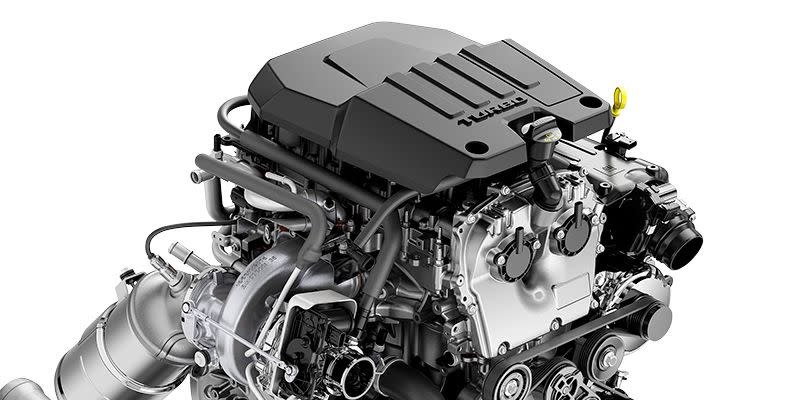General Motors is Pushing the Limits of the Four-Cylinder Engine

Once, gargantuan inline-fours ruled the world. In 1909, a 200-hp 21.5-liter four-cylinder powered race-car driver Victor Hémery's Blitzen Benz to a then-outlandish 125.9 mph at Britain's Brooklands circuit. For a moment, it was the fastest car in the world.
General Motors' new turbo 2.7-liter inline-four, code-named L3B, isn't that big. But when it makes its way into GM's full-size-truck lineup this fall, it will be one of the largest gas-fired, spark-ignited inline-fours sold in the U.S. (the Toyota Tacoma has a 2.7-liter four, too). And there aren't likely to be many larger ones. An inline-four can grow only so big before losing its advantages over other configurations with more cylinders.
"A lot of it is packaging," explains Tom Sutter, GM's chief engineer for small gasoline engines. "To make a big four, you need a big piston with a big bore and a long stroke. The length of the engine gets to be an issue as [displacement] gets bigger and bigger." Most fours, after all, aren't going into the enormous schnoz of a full-size Chevy Silverado.

Also, an inline-four is not naturally balanced. "It's based on the physics and kinematics of the crankshaft going round and round and the pistons going up and down and the forces that generates," says Sutter. "In a V-8, you have the 90-degree V, so the forces counterbalance each other." The L3B and all other GM fours displacing more than 1.5 liters use a pair of counter-rotating balance shafts-mounted below the block and above the oil pan-that spin at twice the engine speed. "Those balance shafts do come with parasitic power loss," states Terry Alger, the director of spark-ignited-engine R&D at the Southwest Research Institute in San Antonio, Texas, "but it's worth it to tamp down the second-order imbalances."
Alger also points to the challenge of containing knock in large fours. But if knock isn't a problem for larger-displacement V-8s, why is it an issue for four-cylinders with half the displacement? Because large-bore engines are more prone to knock than those with a long stroke, and, as Sutter notes, the cylinders in an inline-four can be only so long before height becomes a problem. The cylinders in a V engine are positioned at an angle, which means they can be significantly longer while taking up the same amount of vertical space. That arrangement allows engineers to balance bore and stroke length more effectively in V engines than in inline ones. But in the case of the L3B, Sutter says that the combination of direct injection and a turbocharger allowed GM's engineers to optimize the cylinder for good mixture motion (the turbulence of the air-fuel mixture inside the cylinder), which minimizes the potential for knock.
If you ignore its cylinder count, the L3B's 310 horsepower and 348 pound-feet of torque sound like adequate numbers for a full-size truck. And this won't be the last test of the famously V-happy truck community's mores: Ford is planning a hybrid F-150 for 2020, and if Elon Musk's Twitter stream is to be believed, Tesla is working on an EV pickup. In that context, GM's big four might look as brawny as the one in Hémery's Blitzen Benz.
From the October 2018 issue
('You Might Also Like',)

